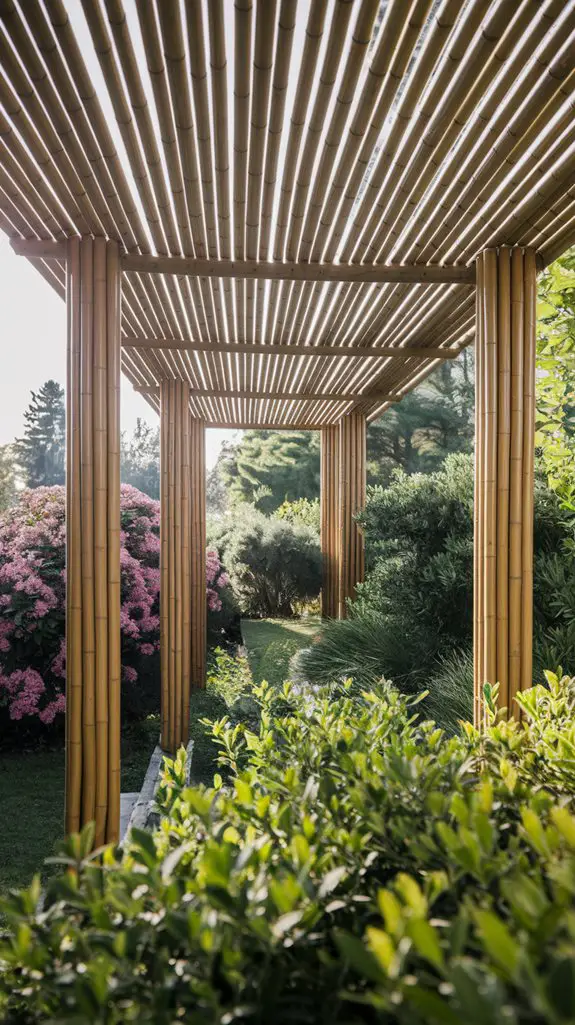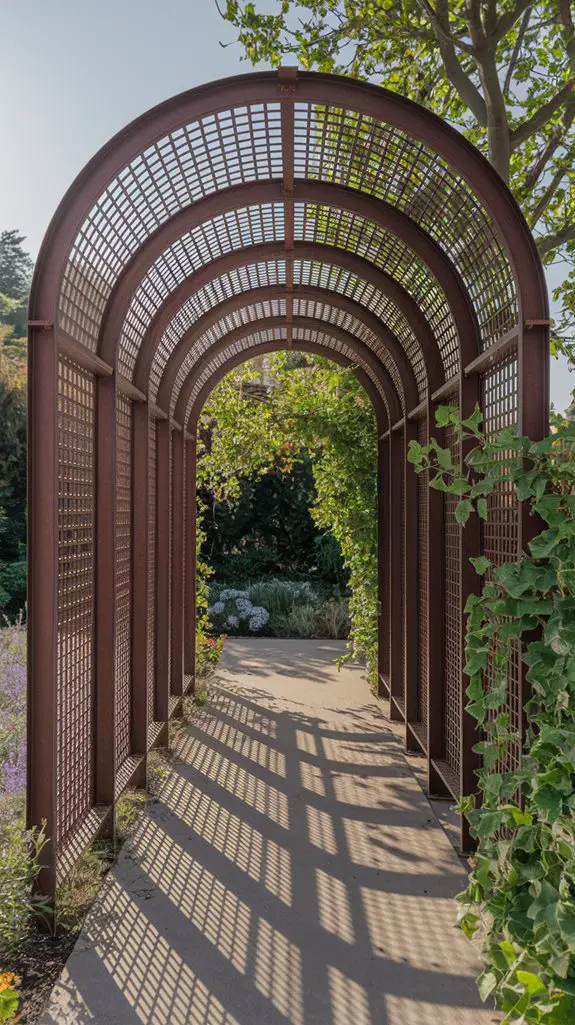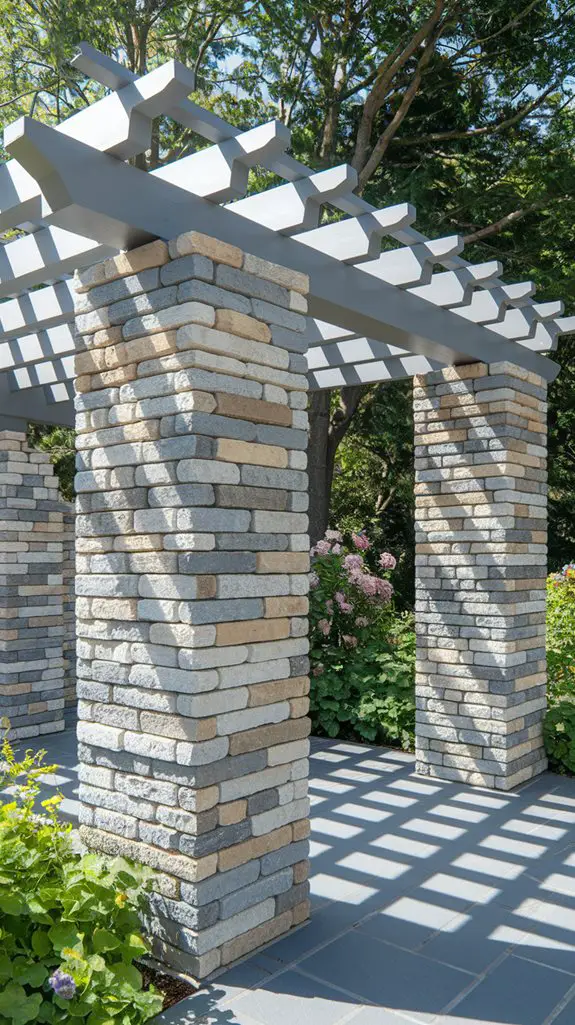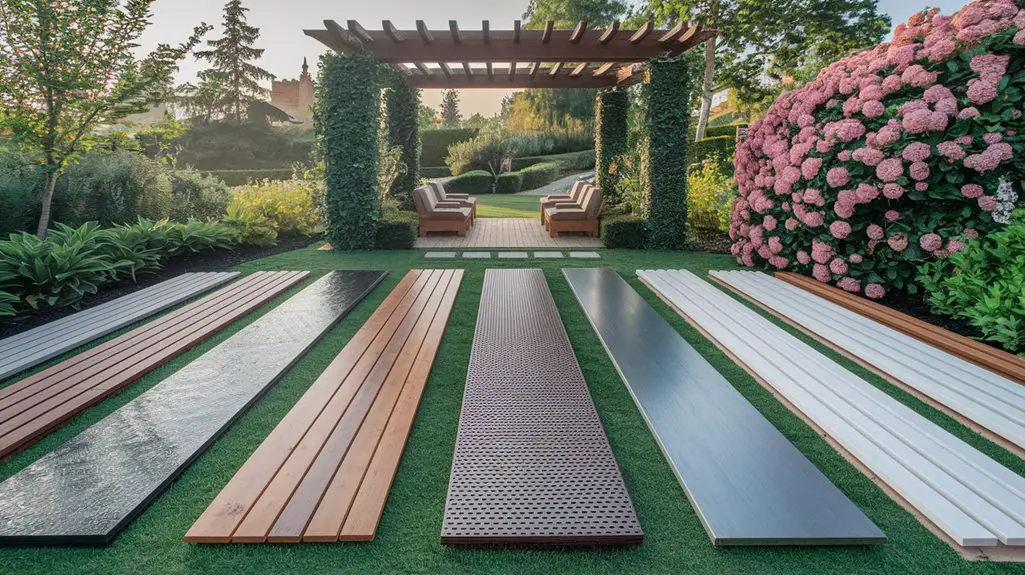The most sustainable pergola in your garden might not require any new materials at all. You'd be surprised how reclaimed barn wood, salvaged architectural elements, and even living plants can create stunning outdoor structures while dramatically reducing environmental impact. These eco-friendly alternatives don't just minimize carbon footprints—they often introduce character and uniqueness impossible to find in mass-produced options. Let's explore these green materials that transform outdoor spaces without transforming our planet.
Reclaimed Wood: Beauty With Environmental Benefits
When considering materials for your eco-friendly pergola, nothing quite matches the character and sustainability of reclaimed wood. Sourced from old barns, factories, and warehouses, these timbers bring history and unique aesthetics to your outdoor space while diverting materials from landfills.
You'll find reclaimed wood offers exceptional durability—these timbers have already withstood decades of weathering and typically come from old-growth forests with denser grain patterns than newer lumber. Each beam tells a story through its patina and character marks.
Look for certified reclaimed dealers who properly clean and prepare the wood. While initially more expensive than new lumber, you're investing in both environmental conservation and a distinctive look that improves with age. Additionally, using reclaimed wood can help support native plant ecosystems by promoting sustainable practices in gardening.
Consider cedar, redwood, or oak varieties for their natural resistance to decay and insects.
Bamboo: Fast-Growing and Sustainable Choice

Although often mistaken for a type of wood, bamboo stands as a grass species that's revolutionizing sustainable pergola construction. You'll appreciate its incredible growth rate—some varieties grow up to 3 feet daily—making it one of the most renewable resources available.
| Feature | Benefit | Sustainability Factor |
|---|---|---|
| Growth Rate | Harvested in 3-5 years | Regenerates without replanting |
| Strength | Tensile strength exceeds steel | Less material needed |
| Versatility | Various sizes available | Minimal processing required |
| Weather Resistance | Naturally water-resistant | No chemical treatments needed |
When building your bamboo pergola, consider species like Moso or Tonkin for structural elements. You'll need proper treatment to extend its outdoor lifespan, but many eco-friendly options exist. The result? A striking, lightweight structure that's reduced your carbon footprint while adding natural elegance to your garden.
Recycled Metal: Durable and Eco-Conscious

The creative repurposing of metal materials offers a compelling alternative for eco-conscious pergola builders. By selecting recycled aluminum, steel, or iron, you're diverting materials from landfills while creating a structure that withstands decades of weather exposure.
Recycled metal pergolas require minimal maintenance compared to wood options—they won't rot, warp, or attract pests. You'll appreciate the sleek, industrial aesthetic that complements both modern and traditional garden designs. Many suppliers now offer metal with certified recycled content percentages, ensuring your environmental claims are verifiable.
Consider combining recycled metal frames with salvaged architectural elements like decorative panels or repurposed piping. These additions create visual interest while further reducing your project's carbon footprint. Additionally, using low-impact materials in your design can enhance sustainability and support environmental goals.
The initial investment may exceed some alternatives, but you'll save considerably on replacement and maintenance costs over time.
Natural Stone: Timeless and Locally Sourced

While recycled metal offers industrial durability, natural stone presents a completely different aesthetic for your eco-friendly pergola project.
Stone columns provide timeless elegance while reducing your carbon footprint, especially when sourced locally. You'll minimize transportation emissions while supporting regional quarries and artisans.
- Limestone, slate, and sandstone offer natural insulation properties that regulate temperature.
- Requires minimal processing compared to manufactured materials.
- Outlasts most other pergola materials, often lasting centuries.
- Can be repurposed from demolition sites for true eco-credentials.
- Naturally resists fire, pests, and extreme weather without chemical treatments.
Additionally, incorporating wildlife-friendly landscaping into your design can enhance the ecological benefits of your pergola.
When paired with reclaimed wooden beams or living vine canopies, stone creates a striking balance between structure and nature that transforms your outdoor space into an eco-conscious retreat.
Hemp-Based Composites: The Emerging Alternative

As innovative materials transform the sustainability landscape, hemp-based composites have emerged as a revolutionary option for eco-conscious pergola builders.
These remarkably strong composites combine hemp fibers with natural resins to create boards and beams that rival traditional lumber in durability.
You'll appreciate that hemp grows rapidly—reaching maturity in just 3-4 months—while requiring minimal water and no pesticides.
Unlike wood, these composites won't rot, warp, or attract insects, extending your pergola's lifespan considerably.
When selecting hemp composites, look for products certified by environmental organizations to guarantee sustainable manufacturing processes.
The material's natural resistance to UV damage makes it ideal for outdoor structures, while its lightweight nature simplifies installation.
Your pergola will also benefit from hemp's natural insulating properties, creating comfortable shade even on hot days. Additionally, these composites can be integrated with innovative rainwater systems to enhance sustainability by efficiently capturing and utilizing rainwater runoff.
Recycled Plastic Lumber: Transforming Waste Into Structure
Recycled plastic lumber stands as perhaps the most transformative innovation in sustainable pergola construction, turning what would be landfill-bound waste into durable, weather-resistant structures.
You'll find this material offers exceptional longevity without the maintenance traditional wood requires.
When considering recycled plastic lumber for your pergola project, note these benefits:
- Requires zero staining, painting, or sealing throughout its lifetime
- Resists rot, insect damage, and moisture warping
- Available in wood-like textures and various colors
- Diverts hundreds of plastic bottles from oceans and landfills
- Withstands extreme weather conditions for 50+ years
Additionally, recycled plastic lumber is an example of green alternatives that contribute significantly to reducing environmental impact.
Your investment in recycled plastic lumber not only creates a stunning outdoor space but also participates in the circular economy, where yesterday's waste becomes tomorrow's living space—truly closing the loop on sustainable construction.
Cork: Renewable Bark With Unique Properties
Cork emerges as an outstanding yet often overlooked material for eco-conscious pergola construction because it's harvested without harming the tree itself. The bark of cork oak trees regenerates every 9-12 years, making it a truly renewable resource.
You'll appreciate cork's natural resistance to moisture, insects, and fire—qualities that extend your pergola's lifespan without chemical treatments. Its lightweight nature simplifies installation while providing excellent thermal and acoustic insulation for your outdoor space.
When treated with natural oils, cork develops a rich patina that ages gracefully in garden settings. Consider using cork panels for shade elements or combining cork with other sustainable materials for structural components.
While it's not ideal for main load-bearing elements, cork offers an innovative touch that aligns perfectly with sustainable landscaping principles. Additionally, incorporating eco-friendly practices in your landscaping can enhance the overall health of your garden and contribute to a vibrant ecosystem.
Sustainable Hardwoods With FSC Certification
While cork offers unique eco-benefits, timber remains a classic pergola material when sourced responsibly.
Look for FSC-certified hardwoods that guarantee sustainable forestry practices, protecting both ecosystems and indigenous communities. These woods combine durability with environmental stewardship.
- Ipe delivers exceptional weather resistance and can last 50+ years without chemical treatments.
- Teak contains natural oils that resist rot, making it ideal for humid climates.
- Black locust offers domestic sustainability with hardness comparable to exotic woods.
- Eucalyptus grows rapidly (ready to harvest in 4-7 years) while remaining remarkably sturdy.
- Accoya uses modified softwoods treated through non-toxic acetylation for hardwood-like performance.
In addition to their environmental benefits, these materials often contribute to sustainable building practices, ensuring that your outdoor projects align with a greener future.
You'll pay more upfront for certified sustainable hardwoods, but their longevity and minimal maintenance requirements deliver better lifetime value while honoring your environmental commitments.
Living Pergolas: Plants as Structure and Shade
For the most sustainable pergola option imaginable, nature itself offers the perfect solution: living plants that serve as both structure and canopy.
You'll create zero waste while fostering biodiversity in your garden space. Fast-growing willows can be trained and woven into living frameworks, while climbing wisteria, grape vines, and kiwi plants provide seasonal shade and food.
These living structures sequester carbon throughout their lives rather than generating carbon debt during manufacturing. Additionally, incorporating native plant species can enhance the ecological value of your garden by attracting local wildlife.
You'll need patience—living pergolas develop over 3-5 years as plants establish themselves. Strategic pruning maintains your desired form while encouraging healthy growth.
Install temporary supports initially that can be removed as the living structure strengthens.
The bonus? Your living pergola evolves continuously, offering changing beauty with each season's growth.
Salvaged Materials: Giving New Life to Architectural Elements
Architectural treasure hunters understand that yesterday's discarded buildings offer today's perfect pergola materials. By salvaging elements from demolition sites, you're not only creating a structure with character but also preventing usable materials from entering landfills.
- Old-growth timber beams from barns provide weather-resistant strength impossible to find in new lumber.
- Wrought iron railings and grates become decorative structural supports with built-in patina.
- Reclaimed brick columns add rustic stability while reducing demand for new clay products.
- Antique doors repurposed as pergola walls create instant visual interest and privacy.
- Weathered window frames can be suspended as canopies, casting patterned shadows below.
Your salvaged pergola tells a story while reducing environmental impact—a perfect marriage of sustainability and style that modern materials simply can't match. Incorporating kid-friendly outdoor seating into your pergola design can enhance its functionality for family gatherings and playdates.
Conclusion
You'll transform your outdoor space while protecting our planet by choosing these eco-friendly pergola materials. While they might initially cost more than conventional options, they'll save you money long-term through durability and minimal maintenance. Each sustainable choice reduces deforestation, mining impacts, and carbon emissions. Your pergola isn't just a garden feature—it's your statement for a regenerative future where beauty and responsibility coexist.




